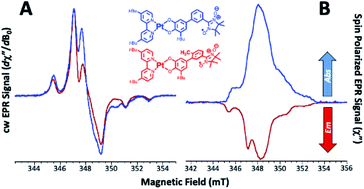Chromophore-radical excited state antiferromagnetic exchange controls the sign of photoinduced ground state spin polarization†
Abstract
A change in the sign of the ground-state electron spin polarization (ESP) is reported in complexes where an organic radical (nitronylnitroxide, NN) is covalently attached to a donor–acceptor chromophore via two different meta-phenylene bridges in (bpy)Pt(CAT-m-Ph-NN) (mPh-Pt) and (bpy)Pt(CAT-6-Me-m-Ph-NN) (6-Me-mPh-Pt) (bpy = 5,5′-di-tert-butyl-2,2′-bipyridine, CAT = 3-tert-butylcatecholate, m-Ph = meta-phenylene). These molecules represent a new class of chromophores that can be photoexcited with visible light to produce an initial exchange-coupled, 3-spin (bpy˙−, CAT+˙ = semiquinone (SQ), and NN), charge-separated doublet 2S1 (S = chromophore excited spin singlet configuration) excited state. Following excitation, the 2S1 state rapidly decays to the ground state by magnetic exchange-mediated enhanced internal conversion via the 2T1 (T = chromophore excited spin triplet configuration) state. This process generates emissive ground state ESP in 6-Me-mPh-Pt while for mPh-Pt the ESP is absorptive. It is proposed that the emissive polarization in 6-Me-mPh-Pt results from zero-field splitting induced transitions between the chromophoric 2T1 and 4T1 states, whereas predominant spin–orbit induced transitions between 2T1 and low-energy NN-based states give rise to the absorptive polarization observed for mPh-Pt. The difference in the sign of the ESP for these molecules is consistent with a smaller excited state 2T1 – 4T1 gap for 6-Me-mPh-Pt that derives from steric interactions with the 6-methyl group. These steric interactions reduce the excited state pairwise SQ-NN exchange coupling compared to that in mPh-Pt.

- This article is part of the themed collections: 2021 Chemical Science HOT Article Collection and Most popular 2021 main group, inorganic and organometallic chemistry articles, 2021


 Please wait while we load your content...
Please wait while we load your content...